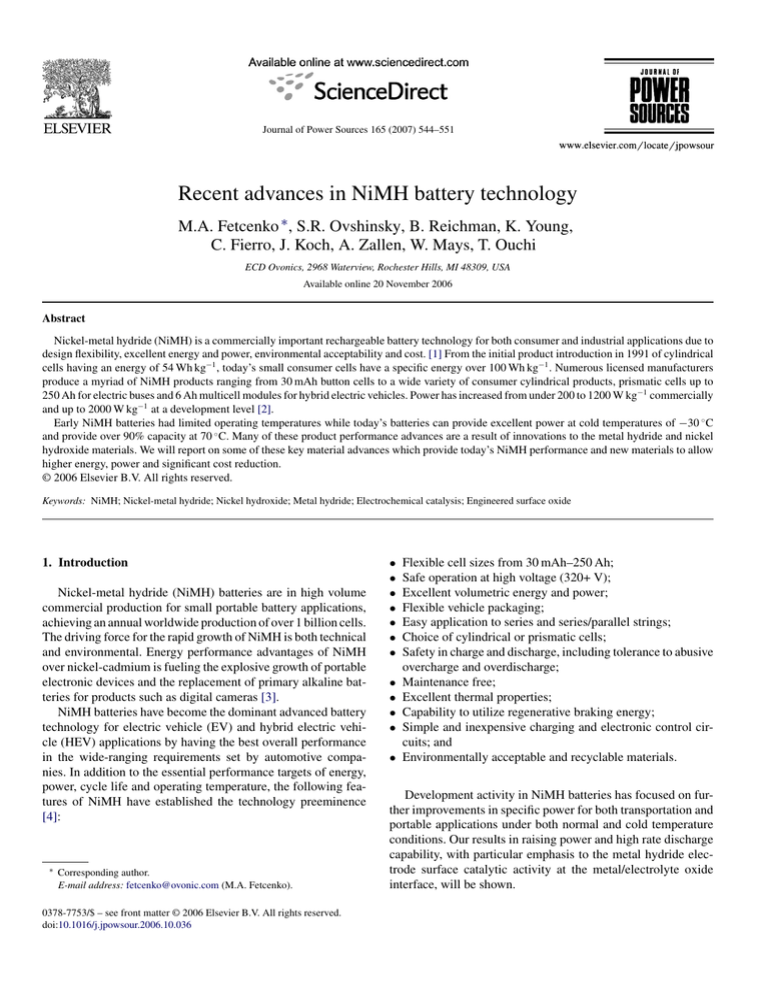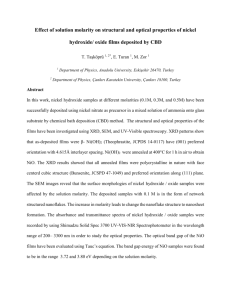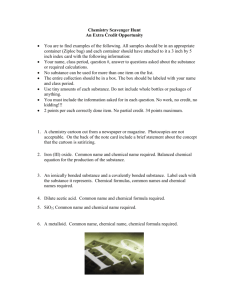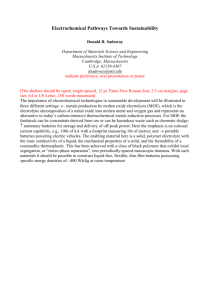
Journal of Power Sources 165 (2007) 544–551
Recent advances in NiMH battery technology
M.A. Fetcenko ∗ , S.R. Ovshinsky, B. Reichman, K. Young,
C. Fierro, J. Koch, A. Zallen, W. Mays, T. Ouchi
ECD Ovonics, 2968 Waterview, Rochester Hills, MI 48309, USA
Available online 20 November 2006
Abstract
Nickel-metal hydride (NiMH) is a commercially important rechargeable battery technology for both consumer and industrial applications due to
design flexibility, excellent energy and power, environmental acceptability and cost. [1] From the initial product introduction in 1991 of cylindrical
cells having an energy of 54 Wh kg−1 , today’s small consumer cells have a specific energy over 100 Wh kg−1 . Numerous licensed manufacturers
produce a myriad of NiMH products ranging from 30 mAh button cells to a wide variety of consumer cylindrical products, prismatic cells up to
250 Ah for electric buses and 6 Ah multicell modules for hybrid electric vehicles. Power has increased from under 200 to 1200 W kg−1 commercially
and up to 2000 W kg−1 at a development level [2].
Early NiMH batteries had limited operating temperatures while today’s batteries can provide excellent power at cold temperatures of −30 ◦ C
and provide over 90% capacity at 70 ◦ C. Many of these product performance advances are a result of innovations to the metal hydride and nickel
hydroxide materials. We will report on some of these key material advances which provide today’s NiMH performance and new materials to allow
higher energy, power and significant cost reduction.
© 2006 Elsevier B.V. All rights reserved.
Keywords: NiMH; Nickel-metal hydride; Nickel hydroxide; Metal hydride; Electrochemical catalysis; Engineered surface oxide
1. Introduction
Nickel-metal hydride (NiMH) batteries are in high volume
commercial production for small portable battery applications,
achieving an annual worldwide production of over 1 billion cells.
The driving force for the rapid growth of NiMH is both technical
and environmental. Energy performance advantages of NiMH
over nickel-cadmium is fueling the explosive growth of portable
electronic devices and the replacement of primary alkaline batteries for products such as digital cameras [3].
NiMH batteries have become the dominant advanced battery
technology for electric vehicle (EV) and hybrid electric vehicle (HEV) applications by having the best overall performance
in the wide-ranging requirements set by automotive companies. In addition to the essential performance targets of energy,
power, cycle life and operating temperature, the following features of NiMH have established the technology preeminence
[4]:
∗
Corresponding author.
E-mail address: fetcenko@ovonic.com (M.A. Fetcenko).
0378-7753/$ – see front matter © 2006 Elsevier B.V. All rights reserved.
doi:10.1016/j.jpowsour.2006.10.036
•
•
•
•
•
•
•
•
•
•
•
•
Flexible cell sizes from 30 mAh–250 Ah;
Safe operation at high voltage (320+ V);
Excellent volumetric energy and power;
Flexible vehicle packaging;
Easy application to series and series/parallel strings;
Choice of cylindrical or prismatic cells;
Safety in charge and discharge, including tolerance to abusive
overcharge and overdischarge;
Maintenance free;
Excellent thermal properties;
Capability to utilize regenerative braking energy;
Simple and inexpensive charging and electronic control circuits; and
Environmentally acceptable and recyclable materials.
Development activity in NiMH batteries has focused on further improvements in specific power for both transportation and
portable applications under both normal and cold temperature
conditions. Our results in raising power and high rate discharge
capability, with particular emphasis to the metal hydride electrode surface catalytic activity at the metal/electrolyte oxide
interface, will be shown.
M.A. Fetcenko et al. / Journal of Power Sources 165 (2007) 544–551
The nickel hydroxide positive electrode has also undergone
rapid evolution. It is common for commercial NiMH batteries to
contain approximately 10% high capacity gamma phase nickel
hydroxide in combination with conventional beta phase nickel
hydroxide [5]. The active materials may also contain multiple
modifier elements to improve charge acceptance, especially at
high temperature [6]. Conductive additives such as filamentary
nickel have been added internally to the nickel hydroxide active
material during precipitation or as external additives in the pasting process [7]. Significant improvements to voltage stability
under storage and cost reduction were accomplished by adopting
cobalt encapsulation techniques to the nickel hydroxide active
material prior to assembling the battery [8]. This paper will
emphasize the nickel hydroxide influence on high temperature
charge efficiency.
2. Experimental
Analysis of the metal hydride surface was conducted by disassembly of discharged C cells in an argon glove box, with the
metal hydride electrode rinsed and dried of KOH. Samples were
prepared for examination by progressive polishing followed by
dimple grinding to a specimen thickness of about 50 m. The
samples were then ion-milled at cryogenic temperature using
3–6 keV argon ions to a specimen thickness of about 500 Å.
Investigation of the MH surface oxide was performed on a JEOL2010 scanning transmission electron microscope (STEM) using
brightfield and darkfield imaging. Crystal structures were studied using selected area electron diffraction (SAED). Quantitative
energy dispersive spectroscopy (EDS) analyses were obtained
using a Cliff-Lorimer thin film correction procedure in conjunction with experimental X-ray correction factors (k-factors)
obtained from thin film standards [9].
Spherical high-tap-density nickel hydroxide precipitates
were prepared in a continuously fed reactor under strong
stirring, at constant pH and temperature [10]. Nickel sulfate,
sodium hydroxide, and ammonium hydroxide solutions were
continuously fed into the reactor. Through an overflow on the
side of the reactor, the nickel hydroxide product and effluent
were collected continuously. Using this method, the precipitates
do not require pulverization or grinding, are composed of
spherical particles, have the high tap density required to
achieve packing density and capacity, and have the crystal
structure, particle size, and surface morphology required for
commercially acceptable battery performance.
Chemical composition was measured using an inductively
coupled argon plasma spectrophotometer (Varian Liberty 100).
Surface area was measured by the BET adsorption method
(Quantachrome instruments, Autosorb-3B). Particle-size
distributions were measured with a laser-diffraction instrument
(Microtrac system, model SRA 150). X-ray diffraction measurements were obtained using a diffractometer (Philips Analytical).
The surface morphology of the nickel-hydroxide particles was
also examined using a scanning electron microscope (JEOL
6320F field-emission scanning electron microscope with
Thermo-Noran Kevex Sigma 32 digital imaging package).
545
3. Results and discussion
3.1. Metal hydride alloys
Early NiMH batteries targeted niche markets due to fundamental power limitations. Metal hydride surface oxidation
limited conductivity, transport of reactants, and catalytic activity. Power restrictions were overcome by engineering the surface
oxide to include extremely small (50–70 Å) metallic nickel particles distributed throughout the oxide, thereby imparting significantly improved catalytic activity [11]. It was found the small
catalysts could be engineered smaller still (10–40 Å), could
include additional elements, and have finer dispersal. These
improvements in catalytic activity enabled dramatic increases
in NiMH power [12].
Early AB5 type metal hydride alloys had a moderate capacity
of about 310 mAh g−1 [13]. AB2 materials were known to have a
higher capacity of about 390 mAh g−1 , but were not widely used
for reasons such as cost, activation, power and charge retention
[14]. Improved AB2 alloys warrant further evaluation. Disordered A2 B7 alloys offer some of the advantages of both AB5
and AB2 material systems including capacities of 390 mAh g−1
simultaneously with high catalytic activity. NiMH AA cells
using such alloys are projected to have a capacity of 3000 mAh.
3.2. Alloy design concept
NiMH batteries are an unusual battery technology in that
the metal hydride active material is an engineered alloy made
up of many different elements and the MH alloy formulas vary
significantly. The active material in the negative electrode is
either of the disordered AB5 (LaCePrNdNiCoMnAl), A2 B7
(LaCePrNdNiCoMnAl plus Mg), or disordered AB2 (VTiZrNiCrCoMnAlSn) type, where the “ABx ” designation refers to
the ratio of the A type elements (LaCePrNd or TiZr) to that
of the B type elements (VNiCrCoMnAlSn). In all cases, the
materials have complex microstructures that allow the hydrogen storage alloys to operate in the aggressive environment (30%
KOH electrolyte, oxygen gas in overcharge recombining at the
MH surface) within the battery where most of the metals are
thermodynamically more stable as oxides.
Electrochemical utilization of metal hydride materials as
anodes in NiMH batteries requires meeting a demanding list
of performance attributes including hydrogen storage capacity, suitable metal-to-hydrogen bond strength, acceptable catalytic activity and discharge kinetics, and sufficient oxidation/corrosion resistance to allow for long cycle life. Multielement, multiphase, disordered alloys of the LaNi5 and VTiZrNiCr
type are attractive development candidates for atomic engineering due to a broad range of elemental addition and substitution, availability of alternate crystallographic phases which form
the matrix for chemical modification, and a tolerance for nonstoichiometric formulas. Through the introduction of modifier
elements, ease of activation and formation has been achieved.
The metal hydride active material has special design options.
The active materials may be adjusted to influence one or more
of capacity, power, and/or cycle life. Disorder permits the extra
546
M.A. Fetcenko et al. / Journal of Power Sources 165 (2007) 544–551
Fig. 1. Evolution of NiMH specific energy.
degrees of freedom which allow for a high level of chemical
substitution [15]. For the AB5 system, a typical formula is
La5.7 Ce8.0 Pr0.8 Nd2.3 Ni59.2 Co12.2 Mn6.8 Al5.0 (atomic percent
a/o). While the capacity of various AB5 alloys is usually around
290–320 mAh g−1 , other overall performance attributes can be
greatly influenced [16]. It is common for the ratio of La/Ce
to be reversed to emphasize cycle life and power. The total
amount of Co, Mn and Al significantly affect ease of activation
and formation but increased cobalt has cost implications. After
production of the AB5 alloy ingot, it is common to further refine
the microstructure of the material by a post anneal treatment
of perhaps 1000 ◦ C for 10 h. The annealing treatment can have
a significant effect on capacity, discharge rate and cycle life
by adjusting crystallite size and grain boundaries, as well as
eliminating unwanted phases precipitated during ingot melting
and casting [17]. Commercial AB5 alloys have a predominantly CaCu5 crystallographic structure. However, within that
structure, there is a range of lattice constants brought about by
compositional disorder within the material that are important
to catalysis, storage capacity and stability to the alkaline environment and embrittlement. These materials also precipitate a
nickel-cobalt phase which is important to high rate discharge
[18].
AB2 alloys also have formula and processing choices.
Popular AB2 alloy formulas (a/o) include V18 Ti15 Zr18 Ni29
Cr5 Co7 Mn8 and V5 Ti9 Zr26.2 Ni38 Cr3.5 Co1.5 Mn15.6 Al0.4 Sn0.8 .
Alloy capacity may range from 385 to 450 mAh g−1 . High
vanadium content alloys may suffer from higher rates of self
discharge due to the solubility of vanadium oxide and its consequent ability to form a special type of redox shuttle [19]. The
concentration of Co, Mn, Al and Sn are important for easy activation, formation, and long cycle life. The ratio of hexagonal C14
to cubic C15 phase is important to emphasize capacity or power.
3.3. Alloy and battery performance
The specific energy of NiMH batteries can vary from 40 to
110 Wh kg−1 depending on the particular application require-
ments. Where device run time is paramount, NiMH batteries
need not have high power capability or even ultra-long cycle
life. On the other hand, for extremely high power charge and
discharge, extra current collection, high N/P ratios (proportion of excess negative electrode capacity to positive electrode capacity), and other cell design and construction decisions can additively affect specific energy. Fig. 1 presents
specific energy improvements over the last 10 years in consumer (portable), cylindrical NiMH cells. For the most common small consumer NiMH batteries, specific energy is usually about 90–110 Wh kg−1 , for EV batteries usually about
65–80 Wh kg−1 , and for HEV batteries and other high power
applications about 45–60 Wh kg−1 [20]. While gravimetric
energy usually receives the attention for advanced battery technologies, in many cases volumetric energy density in watt-hours
per liter is actually more important. NiMH has exceptional
energy density, achieving up to 420 Wh l−1 . Cost reduction is
at the forefront of NiMH development. High volume consumer
battery production has seen NiMH cost at or below the cost
per Kilowatt-hour of NiCd, previously thought to be unobtainable. NiMH cost reduction begins with the recognition that the
technology cost is primarily materials intensive. Efforts to raise
specific energy involves development of metal hydride alloys
with higher hydrogen storage capacity (from 320–385 mAh g−1
active material to 450 mAh g−1 ) and higher utilization
nickel hydroxide (from 240 mAh g−1 active material to
280–300 mAh g−1 ). Each of these higher utilization active materials involves innovative materials research involving highly
modified alloy formulas and advanced processing techniques.
3.4. MH surface oxide and catalysis
A critical design factor within the metal hydride surface oxide
is to achieve a balance between surface oxide passivation and
corrosion. Porosity within the oxide is important to allow ionic
access to the metallic catalysts and therefore promote high rate
discharge. While passivation of the oxide is problematic for high
rate discharge and cycle life, unrestrained corrosion is equally
M.A. Fetcenko et al. / Journal of Power Sources 165 (2007) 544–551
547
Fig. 2. Evolution of NiMH specific power.
destructive. Oxidation and corrosion of the anode metals consumes electrolyte, changes the state of charge balance by release
of hydrogen in the sealed cell, and creates corrosion products
which are capable of poisoning the positive electrode by causing premature oxygen evolution. Establishing a balance between
passivation and corrosion for stability is a primary function of
compositional and structural disorder.
For AB5 , A2 B7 and AB2 metal hydride alloys, the
metal/electrolyte surface oxide interface is a crucial factor in
discharge rate capability and cycle life stability. Fig. 2 shows
how specific power for NiMH batteries has undergone significant change since 1991. Original LaNi5 and TiNi alloys
extensively studied in the 1970s and 1980s for NiMH battery
applications were never commercialized due to poor discharge
rate and cycle life capability. The lack of catalytic activity at the
surface oxide limits high rate discharge and the lack of sufficient
oxidation/corrosion resistance is a critical obstacle to long cycle
life. The complicated chemical formulas and microstructures of
present disordered AB5 and AB2 alloys extends to the surface
oxide. At the oxide, important factors include thickness, microporosity and catalytic activity. In particular, the oxide interface
between the metal hydride and the electrolyte has been identified as essential for low voltage loss under pulse discharge. Of
critical importance to increased discharge rate was the use of
ultrafine metallic nickel alloy particles having a size less than
70 Å dispersed within the oxide. These particles are excellent
catalysts for the reaction of hydrogen and hydroxyl ions, and are
especially important for reducing activation polarization [21].
The ultrafine metallic catalysts are created by preferential
corrosion within the multielement hydrogen storage alloy. In
particular, the dissolution and precipitation of the less noble
vanadium, titanium and zirconium (or La, Ce) allows nickel in
the presence of cobalt, manganese and aluminum to form the
metallic clusters and requires careful design of the surface composition and structure based on the lack of proximity of nickel
atoms in the unit cell. The keys to success of the catalysts are
size, number, density, and topology of the metallic particles.
Nickel in the metallic state is electrically conductive and cat-
alytically active. By further alloying the catalysts with cobalt
(∼20% a/o), the relative size of the catalysts can be reduced
from about on average 50–70 Å to about 10–50 Å. Surface segregation via enrichment and selective oxidation of La in LaNi5
to lower surface energy and the formation of surface nickel precipitates has been previously reported. However, there was no
disclosure of size, composition, proximity or stability of such
precipitates and the resultant surface formation of La(OH)3 and
Ni(OH)2 upon electrochemical cycling was discussed [22].
The catalyst size is important in that at less than 70 Å, there are
an approximately equivalent number of surface atoms and bulk
atoms. The close proximity of the metallic catalysts, typically
about 100 Å apart, may also be referred to as “density of sites”.
It is the interaction of the local chemical electronic bonds with
the reacting H+ and OH− that makes these catalysts so effective,
and it is their metallic nature, size and number which provide
excellent poisoning resistance.
The investigation of the MH surface oxide was conducted
using a scanning transmission electron microscope having the
capability for EDS, SAED and EELS. Fig. 3 presents a high
magnification darkfield TEM image of the surface oxide exhibiting high catalytic activity. The bright inclusions are useful for
determining the size of the catalyst and are indicative of very
strong electron diffraction from nanocrystals having high crystallinity. Wide area EDS shows an enriched nickel surface to be
expected from the preferential corrosion of the other base alloy
constiuents. Fine beam EDS of the inclusions shows almost no
oxygen relative to a high nickel or nickel-cobalt peak intensity while the area surrounding the nickel inclusion is rich in
oxygen. To provide further corroboration, SAED indexing is
consistant with metallic nickel rather than nickel oxide. Comparable tests on earlier low catalytic activity MH materials showed
the absence of inclusions within the oxide under darkfield imaging, a high oxygen signal throughout the oxide under EDS,
SAED patterns characteristic of nickel oxide and EELS spectra indicative of nickel in the +2 oxidation state.
AC impedance measurements of the highly catalytic MH
materials revealed a charge transfer resistance two to three
548
M.A. Fetcenko et al. / Journal of Power Sources 165 (2007) 544–551
Fig. 3. TEM Darkfield micrograph of VTiZrNiCrCoMnAlSn alloy surface oxide having high catalytic activity.
times lower in the alloys having the surface oxide catalytic sites
[23,24]. The resulting higher exchange current density of the
surface modified materials reflects the higher catalytic activity
of the metal oxide surface interface with the electrolyte.
Continued efforts to engineer the surface oxide resulted
in vastly improved cold temperature performance. The oxide
formed a support matrix surrounding the ultrafine metallic
catalysts, but contained insufficient pore structure to allow
rapid transfer of reactants at cold temperature. By engineering
increased porosity and specifically sized pore channels, cold
temperature power increased from practically zero at −30 ◦ C to
over 300 W kg−1 .
Improved cold temperature performance is vital for propulsion applications requiring instant start capability in low temperature climates. Rather than only requiring capacity, these
applications demand specific power be sufficient to operate the
vehicle. Even for commercial HEV NiMH batteries with power
over 1000 W kg−1 at 20 ◦ C, essentially no power capability
was available at −30 ◦ C. Fig. 4 shows the dramatic increase
in cold temperature power when using a modified metal hydride
alloy having a surface engineered to provide improved reactant transfer. Fig. 5 illustrates the modified surface oxide. The
oxide surrounding the ultrafine metallic catalysts exhibited pore
channels of approximately 10–20 Å extending in three directions throughout the surface layer. The channels or voids provide
pathways to and from the ultrafine catalytic particles which promote access of reactant species to the catalysts and removal of
reaction products from the catalytic particles. A conventional
metal hydride alloy surface having excellent room temperature
rate capability but poor cold temperature performance may only
contain approximately 4% void volume while the engineered
surface may contain approximately 20% void as shown in Fig. 6
[25].
NiMH batteries have traditionally suffered very poor low
temperature discharge performance due to the use of aqueous
KOH electrolyte and the resultant generation of H2 O at the surface of the metal hydride electrode during discharge. Power and
high rate discharge capability at −30 ◦ C are diminished in conventional NiMH batteries as the water reaction product freezes
and inhibits the diffusion of the KOH ionic species within the
Fig. 4. Improved NiMH specific power at −30 ◦ C resulting from incorporation of void channels within support oxide.
M.A. Fetcenko et al. / Journal of Power Sources 165 (2007) 544–551
549
Fig. 5. TEM darkfield micrograph of MH surface oxide containing pore channels within support oxide.
surface oxide. It is believed the larger and increased amount of
pore channels within the engineered oxide facilitate the rapid
diffusion of water and ionic species, and mitigate the inherent
limitations of using an aqueous electrolyte. The mechanism is
the same, but the effect of reaction water freezing during cold
discharge causing power degradation has been moved from 0 ◦ C
in conventional NiMH to now providing good power even to
−30 ◦ C.
decreases, and the battery cannot be fully charged [26]. One of
the problems associated with the nickel electrode is the oxygenevolution reaction observed at higher temperatures (Eq. (1)).
This parasitic reaction decreases the battery capacity because a
fraction of the charging current is consumed in the oxygen evolution reaction rather than in the charging of the nickel electrode
itself (Eq. (2)):
4OH− → O2 + 4e− + 2H2 O
(1)
3.5. Nickel hydroxide
Ni(OH)2 + OH− → NiOOH + H2 O + 1e−
(2)
Extensive work has been done on the positive (nickel hydroxide) electrode to improve the charge efficiency of the battery over
a wide temperature range. Since NiMH batteries are frequently
utilized at temperatures that rise well above room temperature,
especially in fast charge applications, high-temperature performance is an active area of research and development.
It is well known that as the temperature of the battery
increases, the charge acceptance of the positive electrode
One way of avoiding the oxygen-evolution reaction and
improving the high-temperature performance of a battery is to
increase the voltage gap between the oxygen evolution potential
and the midpoint voltage of the cell measured during charge. An
important approach for improving the performance of the nickel
hydroxide is to replace a small fraction of the nickel atoms in
the crystal lattice by other atoms. This changes the electrochemical properties of the material and can affect the performance of
Fig. 6. Schematic of surface oxide containing engineered void volumes to assist reactant transfer.
550
M.A. Fetcenko et al. / Journal of Power Sources 165 (2007) 544–551
Table 1
Chemical and physical properties of nickel hydroxide materials studied for high-temperature charge efficiency
Powder
Cationic hydroxide
composition
X-ray FWHM
1 0 1
Particle size
(um)
Tap density
(g cc−1 )
BET surface
area (m2 g−1 )
Powder A
Powder B
Powder C
Powder D
Ni91.3 Co2.4 Zn5.7 Ca0.5 Mg0.1
Ni91.0 Co4.5 Zn4.5
Ni85.5 Co7.0 Zn6.0 Ca1.0 Mg0.5
Ni91.0 Co7.0 Zn0.5 Ca1.0 Mg0.51
1.02
1.05
0.88
0.93
12.0
10.8
8.3
9.8
2.15
2.20
2.19
2.2
16.5
12.8
17.8
10.6
Fig. 7. Improved NiMH high temperature charge efficiency as a result of nickel hydroxide material modification.
the battery at higher temperatures [27]. Compositional modification is accomplished by co-precipitating metal cations with
nickel cations to form the metal hydroxide composed primarily
of nickel (usually >85% by weight) and now alloyed with the
modifier elements. Table 1 shows the chemical formulas and the
physical parameters for the studied materials.
X-ray diffraction analysis shows the presence of hexagonal
crystal structure with the brucite characteristic of nickel hydroxide in the beta phase. The absence of other species confirms that
the co-precipitated elements mainly enter the nickel hydroxide structure, and that they do not form oxides or segregated
hydroxides. This may be considered an unusual result, as many
processes for precipitation of nickel hydroxide result in segregation and non-uniformities.
These powders were tested in sealed, cylindrical C-cell size
nickel metal hydride batteries to study the effect of chemical
composition on high-temperature performance. Charging measurements were made at 25, 45, and 65 ◦ C. It was found that
co-precipitated cobalt in the presence of magnesium, zinc and
calcium increases the voltage gap between the oxygen-evolution
potential and the mid-point voltage of the battery. The larger
voltage gap dramatically increases the charge acceptance of
the battery, improving its charging efficiency (normalized to
the room-temperature value) from around 50% for conventional
nickel hydroxide to 85% for the improved materials when measured at 65 ◦ C.
Fig. 7 displays the temperature dependence of the battery
capacity obtained using each of the powders, normalized with
respect to the capacity at room temperature (25 ◦ C). At 45 ◦ C the
decrease in performance is small for all four powders, though
A is not quite as good as the others. But at 65 ◦ C the differences are very appreciable. The decrease in capacity is only
15% for powder D but is 64% for powder A. High-temperature
performance, from best to worst, follows the order D, C, B,
A. In particular powder D was the best, yielding 98% and
85% of the room-temperature capacity when measured at 45
and 65 ◦ C, respectively. Powder A, with the smallest VG and
with the least amount of cobalt (2.4 atomic%), showed the
worst performance, yielding only 36% of the room-temperature
at 65 ◦ C.
4. Conclusions
Specific power and high rate discharge of metal hydride alloys
for electrochemical application in NiMH batteries was significantly improved by modification of the surface oxide of the metal
hydride alloy. By introducing extremely small metallic nickel
alloy inclusions throughout the oxide by the method of preferential corrosion, catalytic activity was significantly increased
through reduced charge transfer resistance and a specific power
of 1900 W kg−1 was attained. By further modification of the support matrix surrounding the metallic nickel inclusions to increase
M.A. Fetcenko et al. / Journal of Power Sources 165 (2007) 544–551
porosity and reactant transfer channels, the specific power was
increased to 340 W kg−1 at −30 ◦ C.
Excellent high-temperature performance was obtained for
a cobalt-rich zinc-poor powder containing co-precipitated calcium and magnesium. NiMH charging efficiency at 65 ◦ C was
increased from 36% to 85% by formulating the nickel hydroxide
active material to suppress oxygen evolution.
NiMH battery product performance has improved significantly and can be traced to innovative improvements in materials
technology. Development efforts are focused on advanced materials to improve performance in energy, power, temperature
ultra-fast recharge capability, and cost reduction.
References
[1] S.R. Ovshinsky, M.A. Fetcenko, J. Ross, Science 260 (186) (1993).
[2] M.A. Fetcenko, 22nd International Seminar & Exhibit on Primary and
Secondary Batteries, vol. 16, Ft. Lauderdale, FL, 2005.
[3] S.R. Ovshinsky, S.K. Dhar, M.A. Fetcenko, K. Young, B. Reichman, C.
Fierro, J. Koch, F. Martin, W. Mays, B. Sommers, T. Ouchi, A. Zallen, R.
Young, 17th International Seminar & Exhibit on Primary and Secondary
Batteries, vols. 6–9, Ft. Lauderdale, Florida, 2000.
[4] D. Linden, T.B. Reddy (Eds.), Handbook of Batteries, 3rd ed., McGrawHill, New York, 2002.
[5] S.R. Ovshinsky, D. Corrigan, S. Venkatesan, R. Young, C. Fierro, M.A.
Fetcenko, United States Patent 5,348,822 (1994).
[6] C. Fierro, M.A. Fetcenko, K. Young, S.R. Ovshinsky, C. Harrison, United
States Patent 6,228,535 B1 (2001).
[7] M.A. Fetcenko, C. Fierro, S.R. Ovshinsky, B. Sommers, B. Reichman, K.
Young, W. Mays, United States Patent 6,177,213 B1 (2001).
[8] S.R. Ovshinsky, M.A. Fetcenko, C. Fierro, D. Corrigan, P. Benson, F. Martin, United States Patent 5,523,182 (1996).
[9] J.P. Bradley, D.A. Brooks, Analytical Electron Microscopy in Materials
Science, American Laboratory, 1988.
[10] C. Fierro, M.A. Fetcenko, S.R. Ovshinsky, D.A. Corrigan, B. Sommers, A.
Zallen, United States Patent 6,416,903 B1 (2002).
551
[11] M.A. Fetcenko, S.R. Ovshinsky, B. Chao, B. Reichman, United States
Patent 5,536,591 (1996).
[12] M.A. Fetcenko, K. Young, S.R. Ovshinsky, B Reichman, J. Koch, W. Mays,
United States Patent 6,270,719 (2001).
[13] J.R. van Beek, H.C. Donkersloot, J.J.G. Willems, Proceedings of the 14th
International Power Sources Symposium, 1984.
[14] M.A. Gutjahr, H. Buchner, K.D. Beccu, H. Saufferer, in: D.H. Collins, K.
Wada, A. Hiraki (Eds.), Power Sources 4, Oriel, Newcastle upon Tyne,
United Kingdom, 1973, p. 79.
[15] S.R. Ovshinsky, Disordered materials: science and technology, in: D. Adler,
B. Schwartz, M. Silver (Eds.), Institute for Amorphous Studies Series,
Plenum Publishing Corporation, New York, 1991.
[16] M. Latroche, A. Percheron-Guegan, Y. Chabre, J. Bouet, J. Pannetier, E.
Ressouche, J. Alloys Compds. 231 (1995) 537–545.
[17] T. Sakai, H. Miyamura, N. Kuriyama, H. Ishikawa, I. Uehara, J. Alloys
Compds. 192 (1993) 155–157.
[18] P.H.L. Notten, J.L.C. Daams, R.E.F. Einerhand, Ber. Bunsenges. Phys.
Chem. 96 (1992).
[19] M.A. Fetcenko, S. Venkatesan, S. Ovshinsky, Proceedings of the Symposium on Hydrogen Storage Materials, Batteries, and Electrochemistry,
Electrochemical Society, Pennington, NJ, 1992, p. 141.
[20] R.C. Stempel, S.R. Ovshinsky, D.A. Corrigan, IEEE Spectrum 35 (11)
(1998).
[21] S.R. Ovshinsky, M.A. Fetcenko, J. Appl. Phys. 72 (239–244) (2001).
[22] L. Schlapbach, Surface properties and activation, in: L. Schlapbach (Ed.),
Hydrogen in Intermetallic Compounds II, Top. Appl. Phys., vol. 67, 1992,
pp. 42–44, 72–75.
[23] B. Reichman, W. Mays, M.A. Fetcenko, S.R. Ovshinsky, Proceedings of
the Electrochemical Society, volume 97–16, May, 1997.
[24] B. Reichman, W. Mays, K. Young, M.A. Fetcenko, S.R. Ovshinsky, T.
Ouchi, Proceedings of the Electrochemical Society, volume 98–15, October, 1998.
[25] M.A. Fetcenko, S.R. Ovshinsky, K. Young, B. Reichman, T. Ouchi, J. Koch,
W. Mays, United States Patent 6,830,725 (2004).
[26] S.U. Falk, A.J. Salkind, Alkaline Storage Batteries, John Wiley & Sons,
Inc., NY, 1969.
[27] C. Fierro, A. Zallen, J. Koch, M.A. Fetcenko, J. Electrochem. Soc. 153
(2006).




